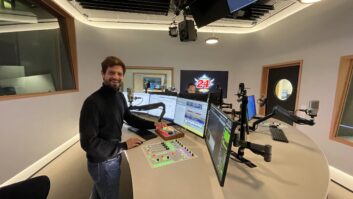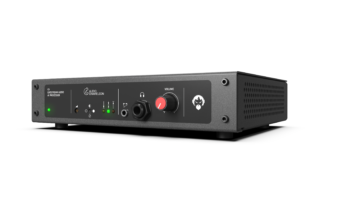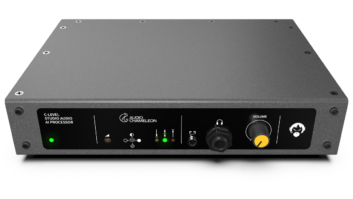On-air processors
Jan 1, 2002 12:00 PM, By Chriss Scherer, editor
Marketplace
Establishing a station’s on-air sound can be a subject of great debate. The original purpose of audio processing, preventing overmodulation and adding pre-emphasis, is still a primary function. Peak level control is even more important for online signals. The point at which general level control ends and the creation of a unique sound begins divides the science and the art. True success is achieved when the two are used together to create an art based on science.
A common pitfall is to use audio processing to compensate for shortcomings in a station’s signal path. Be sure that the audio path before and after the processor is the best that it can be. The STL and first RF stage of the transmitter can also affect performance.
Processing an online signal takes a different approach. While the concern of staying below a maximum level still exists, the transmission medium is different. The quest for on-air loudness does not exist online. This is partially due to streaming being a new medium where listeners do not punch around the dial, but is mostly because streamed signals rely on some type of data reduction of the transmitted signal. The commonly used streaming formats do not work well with signals that have been heavily compressed or clipped. This is the main reason why it is not a good idea to use an off-air signal to feed an online audio encoder.
Separate processing of a direct feed for an online stream involves several cost issues. For more on this, see Managing Technology (page 10). Stations must decide on the appropriate investment for an online stream. Those issues aside, different streaming formats and transmission bandwidths should be processed independently. Compromises can be made along the way.
A better way
Digital signal processing (DSP) has created a new way to design audio processors. By placing the horsepower into software, settings can be created, saved, recalled and modified at the push of a button. DSP also allows new methods to be applied that were not possible or practical with analog circuits.
DSP requires a finite amount of time to perform its function. In some cases, this time may result in an audible delay of the audio signal. In these cases, a separate monitoring path will be necessary for stations normally monitoring an off-air signal.
One change from an analog to a DSP-based processor is acquiring a new set of skills. It seems everyone has his own set of modifications for an analog on-air processor. The skill in using a DSP-based processor is in understanding the design philosophy and the method of signal control.
While DSP processors have gained popularity, analog processors are still widely used and offer valuable features. A compromise between analog and DSP is digital control. Digital control allows precision changes to be applied and repeated. Settings can be copied and saved, and schedules can be created to change processing presets for different types of programming.
Digital control has opened new possibilities by adding external control through a serial port, modem, network card or the Internet, and the ability to upload software revisions as they become available.
Many models are available, each with its own features. Because a processor must be evaluated over a period of time, most manufacturers will arrange a demonstration or short-term loan.
IDT

Products
Digital Band Processor (AM, FM, Internet)
Digital Band Processor in DVP (FM, Internet)
Digital Virtual Processor (AM, FM, Internet)
Peripherals
Digital Encoder Plus (AM, FM)
+33 472 18 19 20
+33 472 18 19 21 fax
www.idt-fr.com
[email protected]
Orban

Products
8400 (FM)
8200 (FM)
6200 (DAB, Internet)
6200S (Internet)
2200 (FM)
9200 (AM)
9100B2 (AM)
1100 PC Card (DAB, Internet)
Peripherals
8218 stereo generator
8200ST studio preprocessor
222A stereo enhancer
510-351-3500
510-351-0500 fax
www.orban.com
[email protected]
Waves

Products
MaxxStream LX (Internet)
MaxxStream M100 (Internet)
MaxxStream
M200 (Internet)
MaxxStream PCI card (Internet)
865-546-6115
865-546-8445
www.waves.com
[email protected]
Omnia Audio

Products
Omnia6 (FM, AM, Internet)
Omnia3 (FM, AM, Internet)
Omnia.fm (FM)
Peripherals
Dividend composite filter
SG Stereo Generator
Omnia plug-in modules
216-241-3443
216-241-4103 fax
www.omniaaudio.com
[email protected]
TC Electronic

Products
DBMax (FM, AM, Internet)
DB-8 (Internet)
805-373-1828
805-379-2648 fax
www.tcelectronic.com
[email protected]
Broadcast Technology Company

Products
Tri-Maze (AM, FM)
Ultramod UM-2000 (FM)
Ultramod FM (FM)
Peripherals
CP-40130 composite processor
CP2013 composite processor
TXL-110 filter/limiter
TXL-210 filter/limiter
DSG-2001 stereo generator
DSG-2001 Ultramod stereo generator
719-688-1439
620-271-7493 fax
www.broadcasttech.com
[email protected]
Aphex

Products
2020 MkII (FM, Internet)
Peripherals
320A Compellor compressor/leveler
323A Compellor/Aural Exciter
720 Domniator II peak limiter
722 Domniator II peak limiter with pre-emphasis
204 Aural Exciter
250 Aural Exciter
818-767-2929
818-767-2641 fax
www.aphex.com
[email protected]
Solid Electronics Labs

Products
Peripherals
DCP-1A composite processor
610-353-9449
610-356-8449 fax
Inovonics

Products
Omega_FM (FM)
WebcCaster (Internet)
222 (AM)
235 (AM)
250 (AM, FM)
255 (FM)
260 (FM)
716 David II (FM)
Peripherals
708 stereo generator
800-733-0552
831-458-0554 fax
www.inovon.com
[email protected]
CRL
Products
Millenium (FM)
Amigo FM (FM)
Amigo AM (AM)
Amigo Talk (AM talk)
AM-4 Mono, includes AGC-400, SEC-400 and PMC-450 (AM)
Peripherals
SG-800A stereo generator
SG-300B stereo generator
AGC-400 mono level controller
SGC-800 stereo level controller
602-438-0888
602-438-8227 fax
www.crlsystems.com
[email protected]
Modulation Sciences
Products
Peripherals
CP-803 composite processor (FM)
StereoMaxx stereo enhancer
CLD-2504 composite distribution amplifier (FM)
CLD-2500 composite line driver
732-302-3090
732-302-0206 fax
www.modsci.com
[email protected]












